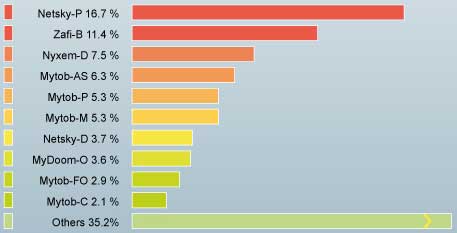Sophos, the security company, has recently announced its list of the Top 10 most dangerous viruses for June 2006. According to the report, the Netsky-P virus continues to dominate the top position on this list.
This is a monthly report compiled from data on the widespread infection rates of various malware strains over the course of a month.
Netsky is an extremely dangerous virus that began spreading vigorously via email since its emergence on the Internet in 2004. Earlier this year, another variant of this virus family appeared and wreaked havoc online, allowing Netsky to maintain its lead in the Top 10 most dangerous viruses for an extended period.
According to statistics from Sophos, during June, the rate of Netsky virus infection reports sent to the company remained steady at 16.7%—the same figure as the previous month—of all virus reports received by Sophos.

Meanwhile, statistics from Kaspersky Lab suggest that the spread of the Netsky virus significantly decreased in June. The company predicts that Netsky will no longer be on the list of top viruses in July.
Additionally, we witnessed a remarkable coup in the June rankings with the Mytob-AS virus variant. In the Top 10 most dangerous viruses list for May, this variant climbed to the 4th position from its previous 10th place in April. By June, it dethroned Zafi-D to take the 2nd position on the chart, accounting for over 10.4% of the infection reports sent to Sophos, while Zafi-D dropped down to the 6th position.
In contrast to Zafi-D’s decline, Nyxem-D maintained its 3rd position with 7.4% of the infection reports sent to Sophos—a decrease of 0.1% compared to the previous month.
The Mytob virus family continued to dominate the June rankings with “5 members,” with Mytob-AS leading at the 2nd position.
This time, the Top 10 most dangerous viruses list for June witnessed the appearance—or rather, the return—of the Bagle virus family. Newly emerged, the latest variant of Bagle quickly claimed the 7th position on the rankings with 3.7% of the infection reports sent to Sophos.
Other types of malicious code accounted for 33.3% of the total infection reports sent to Sophos last month.
Hoàng Dũng


















































